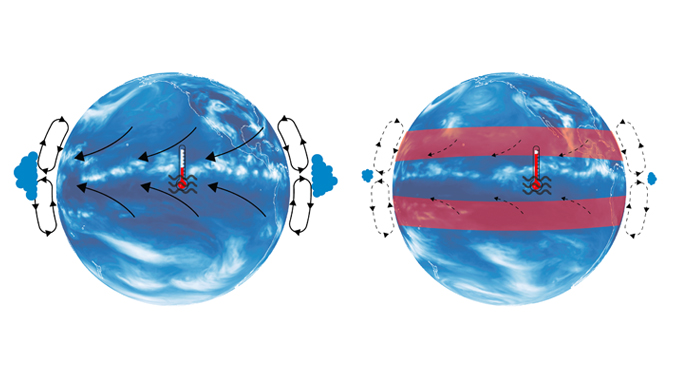
Warming of the subtropics will accelerate future climate change in the tropics, according to a study published this week in Nature Climate Change.
In response to future fossil fuel burning, climate computer models simulate a pronounced warming in the tropical oceans. This warming can influence the El Niño phenomenon and shift weather and rainfall patterns across the globe. Despite being robustly simulated in computer models of the climate system, the origin of this accelerated tropical warming has remained a mystery.
The international research team, led by Malte Stuecker, new assistant professor of oceanography in the University of Hawaiʻi at Mānoa School of Ocean and Earth Science and Technology (SOEST), concluded that climate change outside the tropics is the main culprit.
Earth’s future warming will not be identical everywhere. Atmospheric and oceanic circulation changes, as well as cloud processes, will determine which regions will warm faster and which ones will experience a delayed warming relative to the global mean. Focusing on the tropical regions, a team of scientists developed a new method that separates the contributions from local and remote physical processes that cause warming in a given region.
The team found that the expected future warming in the tropics originates mostly from warming that occurs in subtropical regions.
Remote influence on tropical warming
“To understand this surprising phenomenon, one has to understand how different areas interact with each other climatically,” said Stuecker, who was at the Institute for Basic Science Center for Climate Physics (ICCP) at Pusan National University in South Korea while conducting the study.
A large-scale atmospheric circulation feature referred to as the Hadley cell and its surface branch, known as trade wind circulation, transport relatively dry subtropical air to the tropics. Due to the effects of Earth’s rotation, trade winds also cause upwelling of cold subsurface waters in the tropical Pacific and Atlantic.
“In response to increasing greenhouse gas emissions, future subtropical warming will slow down the atmospheric Hadley cell,” adds Stuecker.
This will lead to a weakening of the surface trade winds, less upwelling of cold ocean water, and a resulting warming of the sea surface. In addition, a weaker Hadley cell also means that less humid air is rising, and cloud coverage is reduced in most of the tropics, increasing the amount of sunlight reaching the surface.
“This can further exacerbate future warming in the tropics,” says Axel Timmermann, director of the ICCP and co-author of the study.
The study presents a new paradigm to understand the patterns of future global warming and the arising regional differences.
“Warming in one area can affect the degree of warming in another place. We are starting to appreciate how strongly different areas are connected in the climate system” said Fei-Fei Jin, co-author and atmospheric sciences professor at SOEST.
Read the full story on the SOEST website.
—Content courtesy of Kyungmi Park, Institute for Basic Science Center for Climate Physics, Pusan National University

